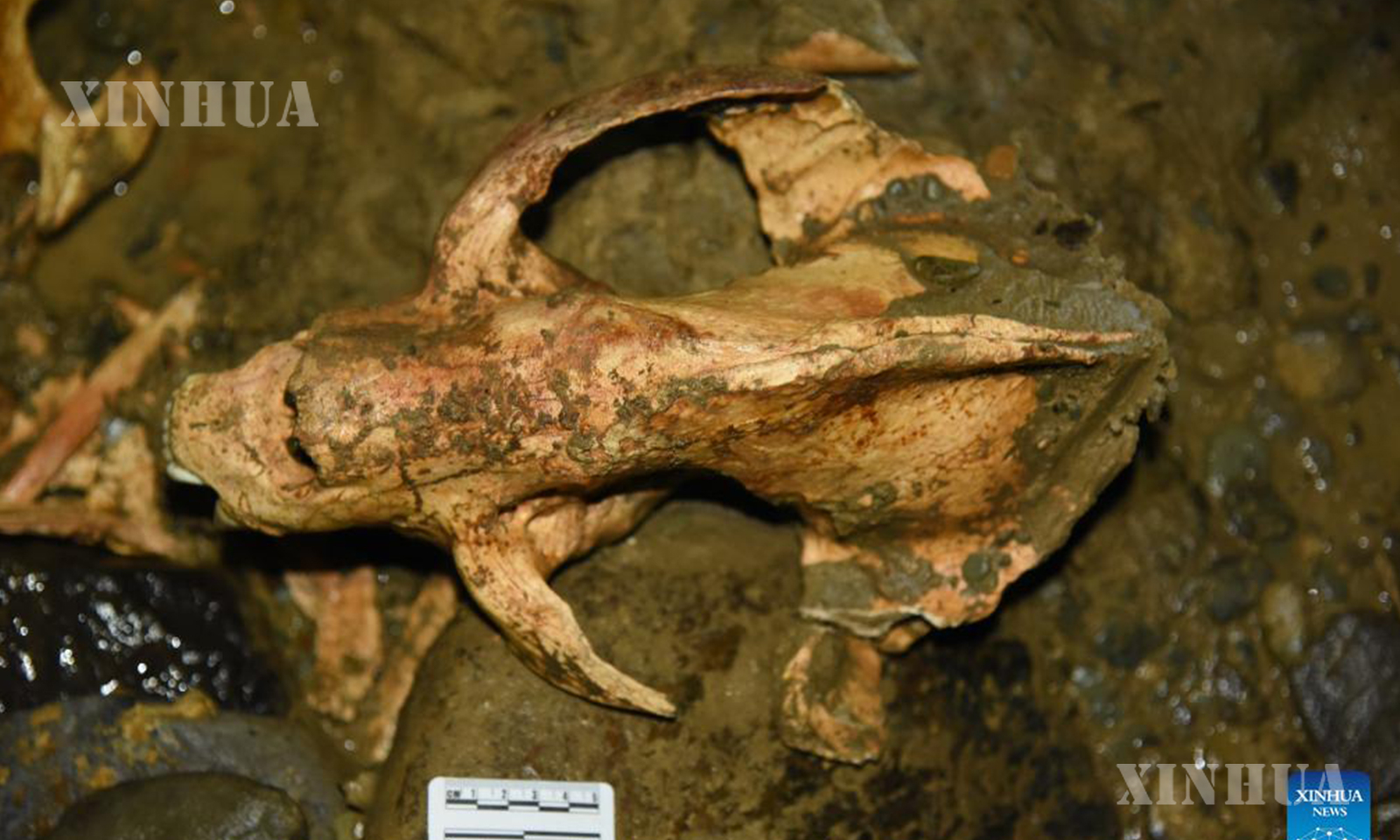Culture & Entertainment
တရုတ်နိုင်ငံ၌ နှစ်ပေါင်း ၁၀၀,၀၀၀ ကျော် သက်တမ်းရှိ ပန်ဒါကြီးမျိုးရုပ်ကြွင်း တွေ့ရှိ

ကွေ့ယန် ၊ ဒီဇင်ဘာ ၉ ရက်(ဆင်ဟွာ)
တရုတ်နိုင်ငံ အနောက်တောင်ပိုင်း ကွေ့ကျိုးပြည်နယ်ရှိ အာရှ၏ အရှည်လျားဆုံး လိုဏ်ဂူအတွင်း နှစ်ပေါင်း ၁၀၀,၀၀၀ ကျော် သက်တမ်းရှိ ပန်ဒါကြီးမျိုးရုပ်ကြွင်းအား တူးဖော်တွေ့ရှိခဲ့ကြောင်း သုတေသီများက ဒီဇင်ဘာ ၈ ရက်တွင် ပြောကြားခဲ့သည်။ကွေ့ကျိုး သိပ္ပံအကယ်ဒမီလက်အောက်ရှိ တောင်အရင်းအမြစ်များ အဖွဲ့အစည်းမှ သုတေသီများသည် Zunyi မြို့ Shuanghe လိုဏ်ဂူအတွင်း မျိုးစိတ်များ၏ ရုပ်ကြွင်းနှစ်ခုအား တွေ့ရှိခဲ့သည်။ သွားအပေါ်ယံကြွေသား သက်တမ်းသတ်မှတ်သည့် နည်းပညာများ၏ အကူအညီဖြင့် ရုပ်ကြွင်းများအနက် တစ်ခုမှာ လွန်ခဲ့သော နှစ်ပေါင်း ၁၀၂,၀၀၀ ခန့်က နေထိုင်ကျက်စားသည့် တောရိုင်းပန်ဒါကြီးမျိုး တစ်ကောင်ကို ညွှန်ပြနေပြီး အခြားရုပ်ကြွင်းသည် လွန်ခဲ့သော နှစ်ပေါင်း ၄၉,၀၀၀ ဝန်းကျင်က ကမ္ဘာမြေပေါ်တွင် တည်ရှိခဲ့ဖွယ် ရှိကြောင်း သိရသည်။

ကွေ့ကျိုး သိပ္ပံအကယ်ဒမီလက်အောက်ရှိ တောင်အရင်းအမြစ်များ အဖွဲ့အစည်းမှ သုတေသီများ တွေ့ရှိခဲ့သည့် ပန်ဒါကြီးမျိုးရုပ်ကြွင်းအား တွေ့ရစဉ်(ဆင်ဟွာ)
မည်သည့်နေရာတွင်မဆို ထိုကဲ့သို့ ကောင်းမွန်စွာ မူလအခြေအနေကို ထိန်းသိမ်းထားသည့် ပန်ဒါကြီးမျိုး ရုပ်ကြွင်းများအား ရှာဖွေတွေ့ရှိရန်မှာ ရှားပါးကြောင်း အဖွဲ့အစည်း၏ သုတေသနလက်ထောက်ဖြစ်သူ Wang Deyuan က ပြောကြားခဲ့သည်။

ကွေ့ကျိုး သိပ္ပံအကယ်ဒမီလက်အောက်ရှိ တောင်အရင်းအမြစ်များ အဖွဲ့အစည်းမှ သုတေသီများ တွေ့ရှိခဲ့သည့် ပန်ဒါကြီးမျိုးရုပ်ကြွင်းအား တွေ့ရစဉ်(ဆင်ဟွာ)
ပြည်ပကျွမ်းကျင်ပညာရှင်များနှင့် နောက်ဆုံး သိပ္ပံနည်းကျပူးတွဲသုတေသနတွင် ရုပ်ကြွင်းများအတွင်း radial sesamoid အရိုးများ၏ သက်သေအထောက်အထားများအား ရှာဖွေတွေ့ရှိခဲ့ကြောင်း သိရသည်။
ပန်ဒါကြီးများသည် အစာစားချိန်တွင် ဝါးအား ကိုင်တွယ်ရန် လက်မအား အသုံးပြုခြင်းကြောင့် ဖြစ်သည်။မျိုးစိတ်များ၏ ခြေလက်အင်္ဂါများသည် အခြားဝက်ဝံများနှင့် ကွဲပြားခြားနားပြီး အပိုလက်မ ရှိသည်။တကယ်တမ်းတွင် လက်မသည် ပုံမှန်မဟုတ်သောကြီးမားသည့်လက်ကောက်ဝတ်အရိုးတစ်ရိုးဖြစ်ပြီး ယင်းလက်မသည် မျှစ်စို့များကို လက်ထဲဆုပ်ကိုင်ရာတွင် ကူညီပေးကြောင်း သိရသည်။

ကွေ့ကျိုး သိပ္ပံအကယ်ဒမီလက်အောက်ရှိ တောင်အရင်းအမြစ်များ အဖွဲ့အစည်းမှ သုတေသီများ တွေ့ရှိခဲ့သည့် ပန်ဒါကြီးမျိုးရုပ်ကြွင်းအား တွေ့ရစဉ်(ဆင်ဟွာ)
ရှာဖွေတွေ့ရှိမှုတွင် ပန်ဒါကြီးမျိုးများသည် ထိုအချိန်က ယခုခေတ် ပန်ဒါများကဲ့သို့ ဝါးအား လှမ်းဆွဲယူရန် ပြောင်းလွယ်ပြင်လွယ်သော ရှေ့လက် ၊ ရှေ့ခြေများအား အသုံးပြုခြင်းဖြင့် ဇီဝကမ္မအခြေအနေများ ရှိနှင့်နေပြီး ဖြစ်ကြောင်း ထပ်ဟပ်နေသည်။ ရှာဖွေမှုများသည် မျိုးစိတ်များ၏ အစာစားခြင်းဝိသေသလက္ခဏာများ၏ဆင့်ကဲဖြစ်စဉ်အား နက်ရှိုင်းစွာ နားလည်သဘောပေါက်ရန် ကူညီပေးကြောင်း Wang Deyuan က ပြောကြားခဲ့သည်။
Shuanghe လိုဏ်ဂူသည် ထိုစဉ်အချိန်က အစိတ်အပိုင်းများစွာ ဆက်စပ်ပါဝင်သည့် အတွင်းပိုင်းဖွဲ့စည်းပုံ နှင့် အပေါက်များစွာကို အတွဲလိုက်ချိတ်ဆက်ထားခြင်းကြောင့် ပန်ဒါကြီးမျိုးများအတွက် သင့်လျော်သည့် နေရာ ဖြစ်သည်။ ယခုအထိ ပန်ဒါကြီးမျိုး ရုပ်ကြွင်း ၃၀ နီးပါးအား လိုဏ်ဂူအတွင်း ရှာဖွေတွေ့ရှိခဲ့ကြောင်း သိရသည်။
ယင်းလိုဏ်ဂူသည် နို့တိုက်သတ္တဝါရုပ်ကြွင်းအရင်းအမြစ်များ ပေါကြွယ်ဝသည်။ မြေခွေးများ ၊ ကြံများ ၊ ဝက်ဝံနက် ၊ stegodon များ ၊ ကြီးမားသည့် အိန္ဒိယကြောင်ကတိုးများ၏ ရုပ်ကြွင်းများ နှင့် အခြားတိရစ္ဆာန်များအား ယခင်တူးဖော်မှုများအတွင်း တွေ့ရှိခဲ့ကြောင်း သိရသည်။ (Xinhua)
—————————————————-
(English Version)
Over 100,000-year-old giant panda fossil found in China
GUIYANG, Dec. 8 (Xinhua) — A giant panda fossil, dating back over 100,000 years, has been uncovered in Asia’s longest cave in southwest China’s Guizhou Province, researchers said Wednesday.
Researchers from the Institute of Mountain Resources under Guizhou Academy of Sciences found two fossils of the species in Shuanghe Cave, Zunyi City. With the help of tooth-enamel dating technologies, one of the fossils indicates a wild giant panda living about 102,000 years ago, and the other is likely to have existed on the planet around 49,000 years ago.
It is rare to discover such well-preserved giant panda fossils anywhere, said Wang Deyuan, research assistant of the institute.
In the latest joint scientific research with foreign experts, evidence of radial sesamoid bones was discovered in the fossils.
Because giant pandas use thumbs to hold and manipulate bamboo while eating, the limbs of the species are different from those of other bears, with an extra ‘thumb.’ The ‘thumb’ is, in fact, an abnormally enlarged wrist bone, and it helps the species grasp bamboo shoots.
The discovery reflects that giant pandas, at that time, already had the physiological conditions of using forepaws flexibly to grab bamboo, like modern pandas. The finding helps deepen understanding of the species’ evolution of its feeding characteristics, said Wang.
Shuanghe Cave was suitable habitat for giant pandas, at the time, due to its complex internal structure and many holes connected in series. So far, nearly 30 giant panda fossils have been discovered in the cave.
The cave is rich in mammal fossil resources. Fossils of jackals, rhinoceroses, black bears, stegodons, large Indian civets, and other animals have been found in previous excavations. Enditem
Photo 1 – Undated handout photo shows a giant panda fossil found by researchers from the Institute of Mountain Resources under Guizhou Academy of Sciences. A giant panda fossil, dating back over 100,000 years, has been uncovered in Asia’s longest cave in southwest China’s Guizhou Province, researchers said Wednesday. Researchers from the Institute of Mountain Resources under Guizhou Academy of Sciences found two fossils of the species in Shuanghe Cave, Zunyi City. With the help of tooth-enamel dating technologies, one of the fossils indicates a wild giant panda living about 102,000 years ago, and the other is likely to have existed on the planet around 49,000 years ago. (Institute of Mountain Resources under Guizhou Academy of Sciences/Handout via Xinhua)
Photo 2 – Undated handout photo shows a giant panda fossil found by researchers from the Institute of Mountain Resources under Guizhou Academy of Sciences. A giant panda fossil, dating back over 100,000 years, has been uncovered in Asia’s longest cave in southwest China’s Guizhou Province, researchers said Wednesday. Researchers from the Institute of Mountain Resources under Guizhou Academy of Sciences found two fossils of the species in Shuanghe Cave, Zunyi City. With the help of tooth-enamel dating technologies, one of the fossils indicates a wild giant panda living about 102,000 years ago, and the other is likely to have existed on the planet around 49,000 years ago. (Institute of Mountain Resources under Guizhou Academy of Sciences/Handout via Xinhua)
Photo 3 – Undated handout photo shows a giant panda fossil found by researchers from the Institute of Mountain Resources under Guizhou Academy of Sciences. A giant panda fossil, dating back over 100,000 years, has been uncovered in Asia’s longest cave in southwest China’s Guizhou Province, researchers said Wednesday. Researchers from the Institute of Mountain Resources under Guizhou Academy of Sciences found two fossils of the species in Shuanghe Cave, Zunyi City. With the help of tooth-enamel dating technologies, one of the fossils indicates a wild giant panda living about 102,000 years ago, and the other is likely to have existed on the planet around 49,000 years ago. (Institute of Mountain Resources under Guizhou Academy of Sciences/Handout via Xinhua)
Photo 4 – Undated handout photo shows a giant panda fossil found by researchers from the Institute of Mountain Resources under Guizhou Academy of Sciences. A giant panda fossil, dating back over 100,000 years, has been uncovered in Asia’s longest cave in southwest China’s Guizhou Province, researchers said Wednesday. Researchers from the Institute of Mountain Resources under Guizhou Academy of Sciences found two fossils of the species in Shuanghe Cave, Zunyi City. With the help of tooth-enamel dating technologies, one of the fossils indicates a wild giant panda living about 102,000 years ago, and the other is likely to have existed on the planet around 49,000 years ago. (Institute of Mountain Resources under Guizhou Academy of Sciences/Handout via Xinhua)






